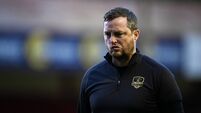Eoin Keith Q&A: 'You can measure the time with a calendar and the distance with an atlas'

I wasn’t really much of a runner at all growing up. My first run was a marathon when I was aged 30, back in 1998. Only a year or two after that I did my first ultra and as the years go by, I discovered that the longer the races are, the better I manage to get in results. Unfortunately, there’s no limits there (laughs). I’ve done some of the longest races in the world, and I’m still pushing it out.














